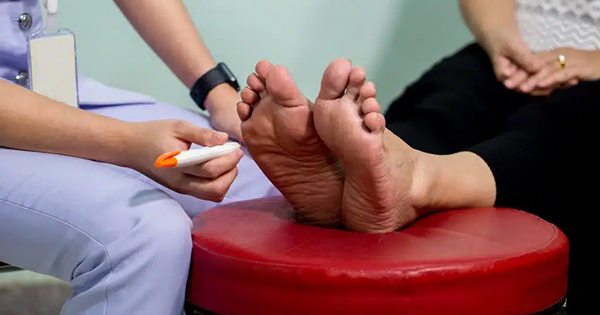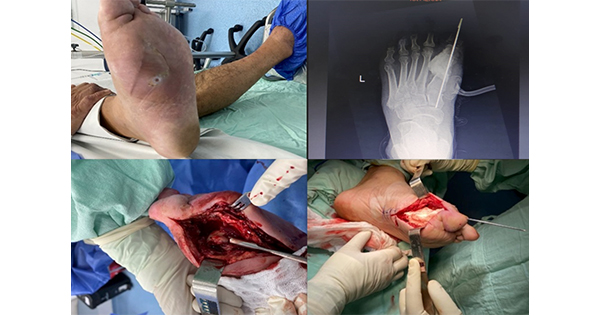Non-medical prescribing has been driven to address a number of health service issues, such as access to services in times of increasing service demands, ageing population and chronic disease burden to meet the demands of the modern National Health Service. Following ministerial approval, the medicines legislation was amended in 2013 permitting podiatrists in England the right to become independent prescribers. A requirement is completion of recognised training and attainment of the appropriate annotation on the Health and Care Professional Council (HCPC) register. By 2015, this legislative change had also been made in Scotland, Wales and Northern Ireland allowing podiatrists to prescribe appropriate medication from the British National Formulary (BNF).
The College of Podiatry (2014) stated that “it is necessary to direct those members who are engaged in the practice of prescribing of medicines to ensure that they concern themselves only with those medicines which are relevant to the treatment of disorders affecting the foot and associated structures, in line with current practice and consistent with published professional guidance.”
This status brings responsibility, accountability and the need for prescribers to work within their own sphere of competence. The Royal Pharmaceutical Society (2016) Framework has been endorsed by professional bodies representing other prescribers, including podiatrists and can be used as a framework to support safe, evidence-based consistent prescribing practice. It is important to note that responsibility for medicines management does not rest solely with those who are registered as independent prescribers, but also includes all practitioners who are directly involved in the management of patient care.
It is recognised that patients with diabetes frequently have additional comorbidities and can be prescribed a significant number of medications. In many instances, this is an appropriate part of complex disease management, however, this may become inappropriate where patients are taking medications that are no longer required, are not achieving a therapeutic effect or pose an unacceptable risk of adverse drug reactions. While there is not an expectation that podiatrists will be prescribing for comorbidities out with their scope of practice, there is a need to have an understanding of the actions and interactions of the full range of medications prescribed, as well as those obtained over the counter or accessed via other means, when managing the diabetic patient for foot lesions or painful peripheral neuropathy.
Gabapentin and pregabalin are both drugs that are prescribed for peripheral neuropathic pain and both can be subject to misuse. However, for the purpose of this discussion the focus will be restricted to one drug, gabapentin, to illustrate the challenges and complexity of prescribing.
The World Health Organization’s (2006) definition of drug misuse is “the use of a substance not consistent with legal or medical guidelines”. Of concern to patients with diabetic neuropathy is the risk of dependence on the long-term use of gabapentin or need for doses far exceeding the maximum safe recommendations. Whereas, obtaining the drug by prescription and diverting to others for use or financial gain is illegal.
Estimates in the UK of incidence of painful diabetic neuropathy is 15 per 100,000 person-years for painful diabetic neuropathy, with rates increasing for painful diabetic neuropathy over time (Hall, 2006). NICE Clinical guideline CG173 (2013) cited prevalence of painful diabetic neuropathy between 16% and 26% of people with diabetes.
The NICE guideline and Presquipp (2016) cites the use of gabapentin as one of the first-line treatments for neuropathic pain. Although generally considered to be a safe and effective treatment, concerns have been raised regarding the prescription of this drug to those who have a known or suspected drug dependency or where there is an increased risk of inappropriate use or diversion of medication. “Misuse of gabapentin and pregabalin, also used for chronic pain, is a major new emerging problem” (Lawrence et al, 2017). The Office for National Statistics (2016) reported that overall prescribing trends in England for 2013 showed a 46% rise in gabapentin prescriptions over a 2-year period and official figures in England and Wales show that the number of deaths linked to gabapentin rose from eight in 2012 to 59 in 2016.
For those patients for whom gabapentin is considered to be an appropriate treatment, prescribers, as with all medication, must have an understanding of effective use, actions, interactions and side effects. In addition to this, the clinician should have the ability to detect signs of misuse and an awareness of subsequent action that should be considered where misuse is suspected. There is also a need to ensure patients being prescribed gabapentin are fully aware of therapeutic indications for its use, as well as contraindications and risk factors, at the point of initial prescription.
Why focus on podiatry?
The podiatry profession is in its infancy in terms of independent non medical prescribing practice, with the most experienced practitioners being registered for less than 5 years. As the profession develops, an increasing number of podiatrists will attain independent prescribing status; with podiatrists in general continuing to have an influence on prescribing decisions. With this additional responsibility and accountability comes a need to ensure patient safety and minimise risk.
All clinicians caring for patients with diabetes need to be aware of risk of dependence on gabapentin. However, podiatrists may be best placed, when carrying out diabetic foot care, to identify and highlight any concerns they may have regarding patients who are routinely using gabapentin for painful peripheral neuropathy.
Due to its use in the treatment of peripheral neuropathic pain and the rise in gabapentin prescription rates this is a drug that many podiatry patients have encountered or are actively taking. Public Health England (2014) advises that “Prescribing decisions should be discussed in full with patients and they should be made aware of the importance of their co-morbidities and context in making a safe prescribing decision”.
Gabapentin in neuropathic pain
Gabapentin, together with pregabalin, belongs within the antiepileptic class of drugs although it is licensed for use in the management of peripheral neuropathic pain in the UK. On initiation, the BNF recommends that it is prescribed at 300mg once daily before titrating up until a therapeutic response is achieved up to a maximum safe recommended dose of 3.6 grams per day. Gabapentin is primarily eliminated unchanged by the kidneys. Monitoring of patients renal function is required with dose adjustment for patients with renal impairment. Gabapentin is removed on dialysis and should, therefore, be administered following dialysis.
If the patient has no improvement in symptoms gabapentin should be reduced and stopped. If effective for pain relief, it is suggested that there should be reduction on an annual basis to ascertain ongoing effectiveness.
Gabapentin can also interact with other drugs and patient medication review should take place to reduce risk prior to prescribing. This is particularly pertinent in patients who are on long-term medication and polypharmacy. Holistic patient assessment should also include an awareness of social factors, such as drug dependency, and the patient’s social environment.
Wiffen et al (2017) carried out a Cochrane review of the literature to explore use of gabapentin in management of chronic neuropathic pain in adults and identified side effects, which included dizziness, sleepiness, water retention, and problems with walking each occurred in about 1 in 10 people who took gabapentin. Patients who express side effects which inhibit the ability to perform skilled tasks such as driving may wish to discuss this with a health care professional and should be taken into consideration when treating the patient. British National Formulary (BNF, 2018) cites a number of additional common side effects, for example, abdominal pain, anxiety, convulsions, dizziness, drowsiness, headache, hostility, hypertension, tremor, twitching and vomiting.
Positively, the review also reported that gabapentin generated a 50% or greater reduction in pain associated with diabetes in 4 in 10 people compared with 2 in 10 with placebo. In those patients where pain was reduced by a third or more the effect was evident for 5 in 10 patients taking gabapentin as opposed to 4 in 10 taking a placebo. The use of gabapentin should, therefore, not be discounted, since it may be effective in peripheral neuropathic pain, particularly if all other options have been explored and proved less effective.
Risk of dependence
“Drugs are chemical substances that affect the central nervous system altering the user’s feeling or perceptions” (Davies, 2017). As with many forms of pain relief medication, habitual use may lead to dependence. There is also the potential for misuse or diversion. For those taking gabapentin illicitly or out with medical guidance, it can be associated with feelings of euphoria, improved sociability, a marijuana-like high, relaxation and sense of calm. Negative effects reported include vomiting, demonstrating a zombie-like state, and coma.
Toxic interaction can result when a cocktail of drugs is taken (Davies, 2017). Patients undergoing withdrawal from gabapentin can exhibit a number of symptoms including trembling, sweating, excitation, pallor, exophthalmia, palpitations and headache (Keuma, 2016).
The most recently published data on drug-related deaths in Scotland reported the presence of gabapentin in 17% of post-mortem samples and concluded that it was implicated in the death of 11% of cases (National Records of Scotland, 2017).
Within the context of dug addiction, patients seldom use only one type of drug — commonly patients take a number of drugs. This will be dependent on a number of factors, including availability, effect, cost and likelihood of detection. Patients may also be taking a range of medication from different sources, at the same time; which can include by prescription, over the counter or obtained illegally. Individuals with a history of recreational drug misuse, who take gabapentin will self administer dosages in excess of the maximum safe dosage (3–20 times). In these cases, staged withdrawal with support of addiction services will be required.
Why is there the potential for misuse of gabapentin?
Access to benzodiazepines and opioids is increasingly restricted, so substance users are turning to alternatives; which are currently available by prescription, such as gabapentin and oxycontin. Gabapentin is a low-cost, generic drug with street value of at least £1 per 300mg tablet (Smith et al, 2012; NHS Lothian, 2013). The relative ease of access and availability of gabapentin, street name ‘gabbies’ can help account for its growing illegal market (Smith et al, 2012).
Gabapentinoids are being identified in drug related death reports in the UK (Barnsdale et al, 2014) with high levels of problem use in prisons (Lawrence et al, 2017). Gabapentin is one of five prescription drugs prison health workers identified as medication sought by offenders who either want to get high themselves, or pass on to another prisoner who does (BBC, 2017). One of the reasons may be due to the lack of detection in urine tests at standard drug analysis.
Prevalence of gabapentin misuse in the general population is reportedly 1% (Smith et al, 2016). This translates as 40–65% among individuals with prescriptions and between 15–22% of individuals who abuse opioids. Whereas studies in USA and UK have estimated that between 15 and 22% of people taking opioids are also misusing gabapentin (Smith et al, 2016).
Drugs are classified in UK under the Misuse of Drugs act, 1971. Gabapentin is not currently scheduled as a controlled substance, indicating that there is little potential for abuse and addiction. Gabapentin shares characteristics of medications associated with misuse and addiction, in that it produces a withdrawal syndrome and certain psychoactive effects. The UK government recommended in 2016 that gabapentin is reclassified as a Class C controlled substance (Iacobucci, 2017). Reclassification, if achieved will have implications for prescribing practice since gabapentin would no longer be available on repeat prescription.
Identifying patients at risk
It is important to stress that most patients would be expected to take medication drugs appropriately without misuse.
Podiatrists care for an ageing patient population often with numerous physical comorbidities. The level of polypharmacy required to manage complex conditions increases the likelihood of adverse drug reactions and drug-related mortality rates Identifying development of dependence or drug misuse can, therefore, be a challenge.
Those at risk may include patients with diabetes, who have been habitual drug users for a number of years or those who have become dependent on gabapentin, when prescribed for painful peripheral neuropathy. There are a number of indicators that may suggest that the patient is becoming dependent on gabapentin or suspected that the drug is being diverted to family members or sold on street for financial gain (Table 1).
Reducing risk: some considerations around prescribing gabapentin
When prescribing gabapentin, the clinician should:
- Explore other medications in first instance, e.g. duloxetine
- Medication review should be to explore if other treatments have been used without success
- Best practice would be to provide acute prescription (28-day supply) for a period of time until clear that gabapentin is preferred choice
- Discuss with multidisciplinary team prior to commencing patient on a repeat prescription
- Seek the local addiction service for advice if there are any concerns that patients are misusing their drugs
- Ensure that an annual review takes place to ascertain whether gabapentin is still the optimum choice for pain relief and try to titrate off.
For those patients who are identified with a known substance misuse problem, referral and liaising with specialist addictions service and GP practice will provide multidisciplinary team support. Patients may be resistant to this depending on their current health and social status
Patients who may be diverting drugs
‘Naive’ diversion of medication of recreational prescription medication sharing with a family member or friend may be viewed as common practice, for example, offering tablets to see if it helps their symptoms. If the outcome is that symptoms are resolved, the patients may continue to ‘supply’. Alternatively, the recipient may reveal to their doctor at a subsequent appointment that they had tried the drug and if it was considered effective or not. Despite being carried out in good faith, this would result in the unintentional consequence of illegal activity (Beyene et al, 2014).
Whereas those patients with a known history of substance misuse should be closely monitored for use of gabapentin outwith expected medical guidance or suspected of diversion. Clinicians must also be mindful of the patient who may be obtaining gabapentin for family or friends or vulnerable patients who have their medication taken from them or are coerced into requesting gabapentin for a family member who misuses drugs.
Actions to consider if history of abuse or suspected abuse:
- Consider indicators on table one; and,
- If the patient is known to be on any substitute medication for drug/alcohol misuse, arrange daily clinic appointments to dispense medication by GP or specialist addiction service
- Holistic assessment to establish both physical and psychological features of dependence and for any symptoms of drug withdrawal, mindful that the painful peripheral neuropathy which gabapentin was prescribed for will still need to be managed
- Support patient with a gradual dose taper reduction, which can take place over a week, with support of addictions service and general practitioner. However clients who have been misusing will have been taking the drug in amounts far in excess of the therapeutic dose and, therefore, professional support will be required.
Conclusion
Gabapentin is widely prescribed for a number of conditions and not restricted to the management of diabetic peripheral neuropathic pain. It would be expected that most patients will take drugs appropriately without misuse.
Gabapentin has been considered to highlight the complexities and challenges in prescribing for patients with complex conditions. Non-medical prescribers have a responsibility to ensure that the wider issues around prescribing practice are taken into account to provide safe, person centred care
The CPD module for this article can be found here.




